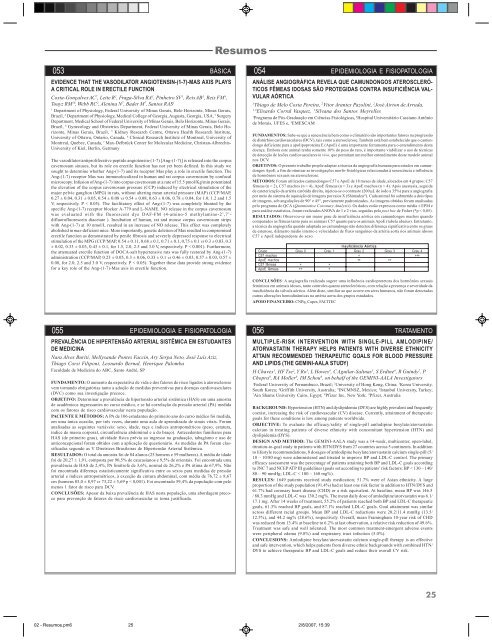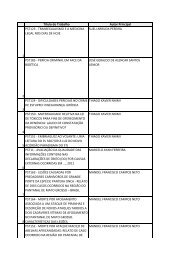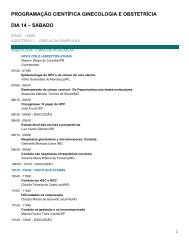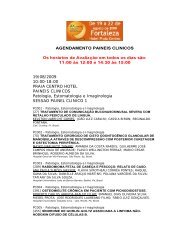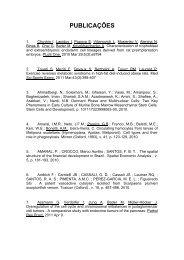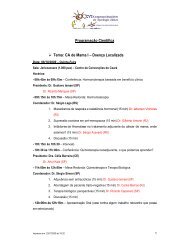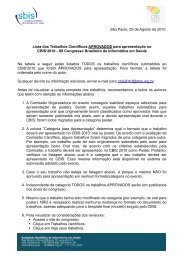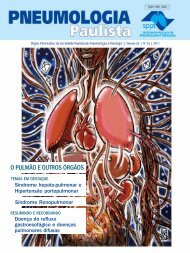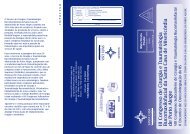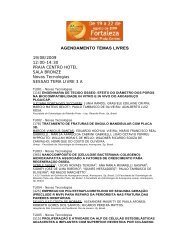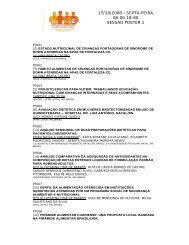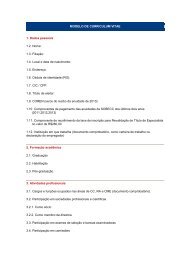Resumos053BÁSICAEVIDENCE THAT THE VASODILATOR ANGIOTENSIN-(1-7)-MAS AXIS PLAYSA CRITICAL ROLE IN ERECTILE FUNCTIONCosta-Gonçalves AC 7 , Leite R 2 , Fraga-Silva RA 1 , Pinheiro SV 1 , Reis AB 3 , Reis FM 4 ,Touyz RM 56 , Webb RC 2 , Alenina N 7 , Ba<strong>de</strong>r M 7 , Santos RAS 11Department of Physiology, Fe<strong>de</strong>ral University of Minas Gerais, Belo Horizonte, Minas Gerais,Brazil, 2 Department of Physiology, Medical College of Georgia, Augusta, Georgia, USA, 3 SurgeryDepartment, Medical School of Fe<strong>de</strong>ral University of Minas Gerais, Belo Horizonte, Minas Gerais,Brazil, 4 Gynecology and Obstetrics Department, Fe<strong>de</strong>ral University of Minas Gerais, Belo Horizonte,Minas Gerais, Brazil, 5 Kidney Research Centre, Ottawa Health Research Institute,University of Ottawa, Ontario, Canada, 6 Clinical Research Institute of Montreal, University ofMontreal, Quebec, Canada, 7 Max-Delbrück Center for Molecular Medicine, Christan-Albrechts-University of Kiel, Berlin, GermanyThe vasodilator/antiproliferative pepti<strong>de</strong> angiotensin-(1-7) [Ang-(1-7)] is released into the corpuscavernosum sinuses, but its role on erectile function has not yet been <strong>de</strong>fined. In this study wesought to <strong>de</strong>termine whether Ang-(1-7) and its receptor Mas play a role in erectile function. TheAng-(1-7) receptor Mas was immunolocalized in human and rat corpus cavernosum by confocalmicroscopy. Infusion of Ang-(1-7) into corpus cavernosum at a rate of 15.5 pmol/Kg/min potentiatedthe elevation of the corpus cavernosum pressure (CCP) induced by electrical stimulation of themajor pelvic ganglion (MPG) in rats, without altering mean arterial pressure (MAP) (CCP/MAP,0.27 ± 0.04, 0.31 ± 0.05, 0.54 ± 0.08 vs 0.54 ± 0.08, 0.63 ± 0.06, 0.78 ± 0.04, for 1.0, 1.2 and 1.5V, respectively. P < 0.05). The facilitatory effect of Ang-(1-7) was completely blunted by thespecific Ang-(1-7) receptor blocker A-779 and L-NAME. NO release in the corpus cavernosumwas evaluated with the fluorescent dye DAF-FM (4-amino-5 methylamino-2’,7’-difluorofluorescein diacetate ). Incubation of human, rat and mouse corpus cavernosum stripswith Ang-(1-7) at 10 nmol/L resulted in an increase of NO release. This effect was completelyabolished in mas-<strong>de</strong>ficient mice. More importantly, genetic <strong>de</strong>letion of Mas resulted in compromise<strong>de</strong>rectile function as <strong>de</strong>monstrated by penile fibrosis and severely <strong>de</strong>pressed response to electricalstimulation of the MPG (CCP/MAP, 0.54 ± 0.11, 0.68 ± 0.1, 0.71 ± 0.1, 0,75 ± 0.1 vs 0.3 ± 0.03, 0.3± 0.02, 0.33 ± 0.03, 0.43 ± 0.1, for 1.5, 2.0, 2.5 and 3.0 V, respectively. P < 0.001). Furthermore,the attenuated erectile function of DOCA-salt hypertensive rats was fully restored by Ang-(1-7)administration (CCP/MAP, 0.23 ± 0.05, 0.3 ± 0.06, 0.33 ± 0.1 vs 0.46 ± 0.03, 0.57 ± 0.03, 0.57 ±0.08, for 2.0, 2.5 and 3.0 V, respectively. P < 0.05). Together these data provi<strong>de</strong> strong evi<strong>de</strong>ncefor a key role of the Ang-(1-7)-Mas axis in erectile function.054EPIDEMIOLOGIA E FISIOPATOLOGIAANÁLISE ANGIOGRÁFICA REVELA QUE CAMUNDONGOS ATEROSCLERÓ-TICOS FÊMEAS IDOSAS SÃO PROTEGIDAS CONTRA INSUFICIÊNCIA VAL-VULAR AÓRTICA1Thiago <strong>de</strong> Melo Costa Pereira, 2 Vitor Arantes Pazolini, 2 José Airton <strong>de</strong> Arruda,1,3Elisardo Corral Vasquez, 1 Silvana dos Santos Meyrelles1Programa <strong>de</strong> Pós-Graduação em Ciências Fisiológicas, 2 Hospital Universitário Cassiano Antônio<strong>de</strong> Morais, UFES e, 3 EMESCAMFUNDAMENTOS: Sabe-se que a senescência bem como o climatério são importantes fatores na progressão<strong>de</strong> distúrbios cardiovasculares (DCV), tais como a aterosclerose. Também está bem estabelecido que o camundongo<strong>de</strong>ficiente <strong>para</strong> a apolipoproteina E (ApoE) é uma importante ferramenta <strong>para</strong> o entendimento <strong>de</strong>stadoença. Embora este animal tenha somente 10% do peso do rato, é importante viabilizar o uso <strong>de</strong> técnicas<strong>de</strong> <strong>de</strong>tecção <strong>de</strong> lesões cardiovasculares in vivo, que permitam um melhor entendimento <strong>de</strong>ste mo<strong>de</strong>lo animalnos DCV.OBJETIVOS: O presente trabalho propõe adaptar a técnica da angiografia humana <strong>para</strong> estudos em camundongosApoE, a fim <strong>de</strong> otimizar as investigações morfo-fisiológicas relacionadas à senescência e influência<strong>de</strong> hormônios sexuais na aterosclerose.MÉTODOS: Foram utilizados camundongos C57 e ApoE <strong>de</strong> 18 meses <strong>de</strong> ida<strong>de</strong>, alocados em 4 grupos: C57fêmeas (n = 2), C57 machos (n = 4), ApoE fêmeas (n = 3) e ApoE machos (n = 4). Após anestesia, seguida<strong>de</strong> cateterização da artéria carótida direita, injetou-se o contraste (200 µL <strong>de</strong> iodo a 35%) <strong>para</strong> a angiografiapor meio do sistema <strong>de</strong> aquisição <strong>de</strong> imagens por raios X (Shimadzu ® ). Cada animal foi submetido a dois tipos<strong>de</strong> imagens, sob angulações <strong>de</strong> 90° e 45°, previamente padronizados. As imagens obtidas foram analisadaspelo programa do QCA (Quantitative Coronary Analysis). Os dados estão expressos como média ± EPM e<strong>para</strong> análise estatística, foram realizados ANOVA <strong>de</strong> 1 e 2 vias, seguidas pelo post hoc <strong>de</strong> Fisher (*p < 0,05).RESULTADOS: Observou-se um maior grau <strong>de</strong> insuficiência aórtica em camundongos machos quandocom<strong>para</strong>dos às fêmeas tanto <strong>para</strong> os animais C57 quanto <strong>para</strong> os animais ApoE (tabela abaixo). Entretanto,a técnica da angiografia quando adaptada ao camundongo não <strong>de</strong>tectou diferença significativa entre os graus<strong>de</strong> estenose, diâmetro médio interno e velocida<strong>de</strong>s <strong>de</strong> fluxo sanguíneo da artéria aorta nos animais idososC57 e ApoE in<strong>de</strong>pen<strong>de</strong>nte do sexo.Insuficiência AórticaGrupo Grau 0 Grau 1 Grau 2 Grau 3 Grau 4C57 machos + +++ApoE machos ++ ++C57 fêmeas + +ApoE fêmeas ++ +CONCLUSÕES: A angiografia realizada sugere uma influência cardioprotetora dos hormônios sexuaisfemininos em animais idosos, tanto controles quanto aterocleróticos, com relação a presença e severida<strong>de</strong> dainsuficiência da válvula aórtica. Além disto, similiar ao que ocorre em seres humanos, não foram <strong>de</strong>tectadasoutras alterações hemodinâmicas na artéria aorta dos grupos estudados.APOIO FINANCEIRO: CNPq, Capes, FACITEC055 EPIDEMIOLOGIA E FISIOPATOLOGIA 056PREVALÊNCIA DE HIPERTENSÃO ARTERIAL SISTÊMICA EM ESTUDANTESDE MEDICINANara Alves Buriti, Mellysan<strong>de</strong> Pontes Faccin, Ary Serpa Neto, José Luís Aziz,Thiago Corsi Filiponi, Leonardo Bernal, Henrique PalombaFaculda<strong>de</strong> <strong>de</strong> Medicina do ABC, Santo André, SPFUNDAMENTO: O aumento da expectativa <strong>de</strong> vida e dos fatores <strong>de</strong> risco ligados à aterosclerosevem tornando obrigatórias tanto a adoção <strong>de</strong> medidas preventivas <strong>para</strong> doenças cardiovasculares(DVC) como sua investigação precoce.OBJETIVO: Determinar a prevalência <strong>de</strong> hipertensão arterial sistêmica (HAS) em uma amostra<strong>de</strong> acadêmicos ingressantes no curso médico, e se há correlação da pressão arterial (PA) medidacom os fatores <strong>de</strong> risco cardiovascular nesta população.PACIENTE E MÉTODOS: A PA <strong>de</strong> 106 estudantes do primeiro ano do curso médico foi medida,em uma única ocasião, por três vezes, durante uma aula <strong>de</strong> aprendizado <strong>de</strong> sinais vitais. Foramanalisadas as seguintes variáveis: sexo, ida<strong>de</strong>, raça e índices antropométricos (peso, estatura,índice <strong>de</strong> massa corporal, circunferência abdominal e a do braço). Antece<strong>de</strong>ntes familiares <strong>para</strong>HAS (<strong>de</strong> primeiro grau), ativida<strong>de</strong> física prévia ao ingresso na graduação, tabagismo e uso <strong>de</strong>anticoncepcional foram obtidos com a aplicação <strong>de</strong> questionário. As medidas <strong>de</strong> PA foram classificadassegundo as V Diretrizes <strong>Brasileira</strong>s <strong>de</strong> Hipertensão Arterial Sistêmica.RESULTADOS: O total da amostra foi <strong>de</strong> 84 alunos (25 homens e 59 mulheres). A média <strong>de</strong> ida<strong>de</strong>foi <strong>de</strong> 20,27 ± 1,91, composta por 90,5% <strong>de</strong> caucasianos e 9,5% <strong>de</strong> orientais. Foi encontrada umaprevalência <strong>de</strong> HAS <strong>de</strong> 2,4%, PA limítrofe <strong>de</strong> 3,6%, normal <strong>de</strong> 26,2% e PA ótima <strong>de</strong> 67,9%. Nãofoi encontrada diferença estatisticamente significativa entre os sexos <strong>para</strong> medidas <strong>de</strong> pressãoarterial e índices antropométricos, à exceção da cintura abdominal, com média <strong>de</strong> 76,72 ± 8,67cm (homens 85,0 ± 8,97 vs 73,22 ± 5,69 p < 0,001). Foi encontrado 59,4% da população com pelomenos 1 fator <strong>de</strong> risco <strong>para</strong> DCV.CONCLUSÕES: Apesar da baixa prevalência <strong>de</strong> HAS nesta população, uma abordagem precoce<strong>para</strong> prevenção <strong>de</strong> fatores <strong>de</strong> risco cardiovascular se torna justificada.TRATAMENTOMULTIPLE-RISK INTERVENTION WITH SINGLE-PILL AMLODIPINE/ATORVASTATIN THERAPY HELPS PATIENTS WITH DIVERSE ETHNICITYATTAIN RECOMMENDED THERAPEUTIC GOALS FOR BLOOD PRESSUREAND LIPIDS (THE GEMINI-AALA STUDY)H Chaves 1 , HF Tse 2 , Y Ro 3 , L Howes 4 , C Aguilar-Salinas 5 , S Erdine 6 , R Guindy 7 , PChopra 8 , RA Moller 8 , IM Schou 9 , on behalf of the GEMINI-AALA Investigators1Fe<strong>de</strong>ral University of Pernambuco, Brazil; 2 University of Hong Kong, China; 3 Korea University,South Korea; 4 Griffith University, Australia; 5 INCMNSZ, Mexico; 6 Istanbul University, Turkey;7Ain Shams University Cairo, Egypt; 8 Pfizer Inc, New York; 9 Pfizer, AustraliaBACKGROUND: Hypertension (HTN) and dyslipi<strong>de</strong>mia (DYS) are highly prevalent and frequentlycoexist, increasing the risk of cardiovascular (CV) disease. Currently, attainment of therapeuticgoals for these conditions is low among patients worldwi<strong>de</strong>.OBJECTIVE: To evaluate the efficacy/safety of single-pill amlodipine besylate/atorvastatincalcium in treating patients of diverse ethnicity with concomitant hypertension (HTN) anddyslipi<strong>de</strong>mia (DYS).DESIGN AND METHOD: The GEMINI-AALA study was a 14-week, multicenter, open-label,titration-to-goal study in patients with HTN/DYS from 27 countries across 5 continents. In additionto lifestyle recommendations, 8 dosages of amlodipine besylate/atorvastatin calcium single-pill (5/10 – 10/80 mg) were administered and titrated to improve BP and LDL-C control. The primaryefficacy assessment was the percentage of patients attaining both BP and LDL-C goals accordingto JNC 7 and NCEP ATP III gui<strong>de</strong>lines (goals set according to patients’ risk factors: BP < 130 – 140/80 – 90 mmHg; LDL-C < 100 – 160 mg%).RESULTS: 1649 patients received study medication; 51.7% were of Asian ethnicity. A largeproportion of the study population (91.4%) had at least one risk factor in addition to HTN/DYS and61.7% had coronary heart disease (CHD) or a risk equivalent. At baseline, mean BP was 146.5/ 88.3 mmHg and LDL-C was 130.2 mg%. The mean daily dose of amlodipine/atorvastatin was 6.1/17.1 mg. After 14 weeks of treatment, 55.2% of patients reached both BP and LDL-C therapeuticgoals, 61.3% reached BP goals, and 87.1% reached LDL-C goals. Goal attainment was similaracross different racial groups. Mean BP and LDL-C reductions were 20.2/11.4 mmHg (13.5/12.5%), and 44.2 mg% (28.6%), respectively. Overall, mean Framingham 10-year risk of CHDwas reduced from 13.4% at baseline to 6.2% at last observation, a relative risk reduction of 49.6%.Treatment was safe and well tolerated. The most common treatment-emergent adverse eventswere peripheral e<strong>de</strong>ma (9.8%) and respiratory tract infection (5.0%).CONCLUSIONS: Amlodipine besylate/atorvastatin calcium single-pill therapy is an effectiveand safe intervention, which helps patients from diverse ethnic backgrounds with combined HTN/DYS to achieve therapeutic BP and LDL-C goals and reduce their overall CV risk.2502 - Resumos.pm6 252/8/2007, 15:39
Resumos057EPIDEMIOLOGIA E FISIOPATOLOGIAPESO AO NASCIMENTO COMO MARCADOR DE ALTERAÇÕES NA PRESSÃOARTERIAL E NA ALBUMINÚRIA DE CRIANÇAS ESCOLARESCláudia Maria Salgado, Paulo César Brandão Veiga Jardim, Flávio BittencourtGonsalves Teles, Mariana Cabral NunesLiga <strong>de</strong> Hipertensão Arterial, Universida<strong>de</strong> Fe<strong>de</strong>ral <strong>de</strong> Goiás, Goiânia, GoiásFUNDAMENTO: O baixo peso ao nascimento (BPN) ou o retardo do crescimento intra-uterinoestá associado com um aumento da incidência <strong>de</strong> hipertensão arterial e doença cardiovascular noadulto. A microalbuminúria (MA) e alteração no ritmo circadiano da pressão arterial (PA) sãoconsi<strong>de</strong>rados fatores <strong>de</strong> risco <strong>para</strong> lesões secundárias à hipertensão.OBJETIVO: Avaliar a influência do peso ao nascimento na pressão arterial e na albuminúria <strong>de</strong>crianças escolares.DELINEAMENTO: Estudo transversal caso-controle.PACIENTE OU MATERIAL: Foram estudadas crianças entre 8 e 11 anos, matriculadas emescolas da região leste da cida<strong>de</strong> <strong>de</strong> Goiânia. Divididas em 2 grupos, um formado por aquelas comBPN (< 2,5 Kg) e outro daquelas com peso ao nascimento normal – PNN (> 3,0 Kg) .MÉTODOS: Avaliadas com relação a PA casual e Monitorização Ambulatorial da Pressão Arterial(MAPA), além da MA em urina <strong>de</strong> 24 horas. Peso (PN) e estatura ao nascimento foramobtidos no cartão da criança. Investigada ida<strong>de</strong> gestacional (termo > 37 e pré-termo < 37 semanas),tempo <strong>de</strong> aleitamento materno exclusivo e antece<strong>de</strong>ntes familiares <strong>de</strong> hipertensão ou diabetes.Realizadas medidas do peso e estatura, <strong>para</strong> cálculo do índice <strong>de</strong> massa corpórea (IMC);exame físico, avaliação da maturação sexual segundo os critérios <strong>de</strong> Tanner (excluídos se índice<strong>de</strong> Tanner > 2).RESULTADOS: Foram 34 crianças com BPN e 34 com PNN. Não houve diferença significantequanto à ida<strong>de</strong>, sexo, raça, peso, estatura, IMC, história familiar <strong>de</strong> hipertensão ou <strong>de</strong> diabetes.As com BPN apresentaram maior pressão sistólica casual (p = 0,007*). Na MAPA, as com BPNtambém apresentaram maior pressão diastólica em 24 horas (p = 0,009*) e em vigília (p = 0,002*),maiores pressão sistólica e diastólica no sono (p = 0,005 e p = 0,001*) e menor <strong>de</strong>scenso noturnoda pressão sistólica (p = 0,001*) do que as crianças com PNN. Observou-se uma correlaçãopositiva entre o PN e o <strong>de</strong>scenso noturno da pressão sistólica (p = 0,022*) e correlação negativado PN com a pressão sistólica <strong>de</strong> sono (p = 0,032*). Na análise <strong>de</strong> regressão múltipla apenas o PNapresentou correlação com o <strong>de</strong>scenso noturno da pressão sistólica (p = 0,032*). Houve maiorexcreção <strong>de</strong> albumina em urina <strong>de</strong> 24 horas nas crianças com BPN (p = 0,015*).CONCLUSÕES: Crianças escolares, com baixo peso ao nascimento apresentam pressão arterialmais elevada, diminuição do <strong>de</strong>scenso noturno da PA e maiores níveis <strong>de</strong> albumina em urina <strong>de</strong>24 horas. Estes achados po<strong>de</strong>m representar um marcador precoce <strong>de</strong> comprometimento da funçãorenal e/ou vascular nas pessoas com BPN, já presente na infância.058EPIDEMIOLOGIA E FISIOPATOLOGIADISTRIBUIÇÃO DE GORDURA CORPORAL E RELATO DE HIPERTENSÃO EMALUNOS DE UNIVERSIDADES PÚBLICAS DE VÁRIAS REGIÕES DO BRASILClaudilei<strong>de</strong> <strong>de</strong> Sá Silva, Poliana Coelho Cabral, Maria Edilma <strong>de</strong> Lima, LevyPetrus Silvestre <strong>de</strong> Lima Silva, Eliane Cunha Mendonça <strong>de</strong> OliveiraDepartamento <strong>de</strong> Nutrição, Universida<strong>de</strong> Fe<strong>de</strong>ral <strong>de</strong> Pernambuco (UFPE)FUNDAMENTO: O acúmulo <strong>de</strong> gordura visceral está fortemente associado à maior prevalência<strong>de</strong> hipertensão arterial e <strong>de</strong>sarranjos metabólicos, hormonais, inflamatórios e hemodinâmicos,que no conjunto implicarão em maior risco cardiovascular.OBJETIVO: Avaliar a ocorrência <strong>de</strong> obesida<strong>de</strong> visceral e hipertensão arterial em alunos <strong>de</strong>universida<strong>de</strong>s públicas <strong>de</strong> várias regiões do BrasilDELINEAMENTO: Estudo <strong>de</strong> caráter transversalPACIENTE OU MATERIAL: 252 alunos <strong>de</strong> universida<strong>de</strong>s públicas <strong>de</strong> várias regiões do Brasil.Os dados foram coletados durante encontro <strong>de</strong> estudantes universitários, realizado em Recife, PE.MÉTODOS: Para avaliar o estado nutricional foi utilizado o IMC com a classificação da OMS(1995). Com o objetivo <strong>de</strong> estimar a distribuição corporal <strong>de</strong> gordura o perímetro abdominal foiavaliado, sendo utilizado os pontos <strong>de</strong> corte da OMS (1998). Além dos dados antropométricosforam coletadas também informações sobre o histórico familiar e a ocorrência (no aluno) <strong>de</strong>outros fatores <strong>de</strong> risco cardiovasculares, tais como: hipertensão (HAS), hipercolesterolemia ediabetes (DM). A construção do banco <strong>de</strong> dados e a análise estatística foi realizada no programaEpi-info versão 6.04. A com<strong>para</strong>ção entre os resultados obtidos foi realizada pelo teste do quiquadradocom correção <strong>de</strong> Yates. Foi adotado o nível <strong>de</strong> significância <strong>de</strong> 5% <strong>para</strong> rejeição dahipótese <strong>de</strong> nulida<strong>de</strong>.RESULTADOS: Os dados <strong>de</strong>sse estudo mostram resultados interessantes, on<strong>de</strong> apenas 8,9% doshomens estão sob risco cardiovascular elevado, enquanto que 43,4% das mulheres encontram-senesta situação (p < 0,05), segundo a classificação <strong>de</strong> risco cardiovascular a partir do perímetroabdominal com pontos <strong>de</strong> corte <strong>de</strong> > 94 cm <strong>para</strong> homens, e <strong>de</strong> >80cm mulheres (OMS, 1998). Noque se refere ao IMC, os dados são ainda mais instigantes, pois somente 12,9% das mulheresapresentaram sobrepeso e 1% obesida<strong>de</strong>, e ao analisar-se os homens encontra-se que 20,7% estãoacima do peso normal e 2,1% são obesos. Com relação ao quadro hipertensivo, 2,7% dos homense 1,9% das mulheres relataram ter conhecimento <strong>de</strong> que são hipertensos.CONCLUSÕES: Os resultados acima mostram que está ocorrendo uma elevada prevalência <strong>de</strong>distribuição <strong>de</strong> gordura corporal andrói<strong>de</strong> nas mulheres, o que preocupa, em virtu<strong>de</strong> da associaçãoentre obesida<strong>de</strong> visceral e risco cardiovascular. Diante dos resultados encontrados, justificasea realização <strong>de</strong> campanhas educativas com enfoque na alimentação saudável e <strong>de</strong> incentivoa prática <strong>de</strong> ativida<strong>de</strong> física visando a prevenção primária <strong>de</strong> eventos cardiovasculares.059 EPIDEMIOLOGIA E FISIOPATOLOGIA 060ESTUDO DA EXPRESSÃO DE RECEPTORES AT1 NO DIABETES EXPE-RIMENTALThiago <strong>de</strong> Melo Costa Pereira, Isabele Beserra Santos Gomes, Silvana dosSantos MeyrellesPrograma <strong>de</strong> Pós-Graduação em Ciências Fisiológicas, UFESFUNDAMENTOS: O diabetes é um fator <strong>de</strong> risco no <strong>de</strong>senvolvimento <strong>de</strong> doenças cardiovasculares,como hipertensão e aterosclerose. Embora a hiperglicemia seja um dos maiores <strong>de</strong>terminantesno <strong>de</strong>senvolvimento <strong>de</strong> complicações sistêmicas, as interações com o sistema reninaangiotensinacontribuem diretamente com os danos associados ao diabetes. Nos estágios iniciaisda doença, a hiperglicemia induz alterações significativas da função renal o que compensatoriamente,eleva a produção <strong>de</strong> angiotensina II (Ang II) <strong>para</strong> a manutenção da pressão sanguínea.Já no diabetes crônico, a manutenção das ações promovidas pela Ang II po<strong>de</strong>m acarretar prejuízoscardiovasculares.OBJETIVOS: Sabendo-se que os efeitos <strong>de</strong>letérios da Ang II são mediados via receptores AT1e que o seu bloqueio <strong>de</strong>monstra benefícios em pacientes diabéticos e hipertensos, nosso trabalhovisa avaliar o efeito do diabetes experimental na modulação da expressão dos receptores AT1<strong>para</strong> Ang II.MÉTODOS: Utilizou-se camundongos C57BL/6, machos, com 18 semanas <strong>de</strong> ida<strong>de</strong>. Os animaisforam divididos nos grupos diabético (n = 4) e controle (n = 4). O diabetes foi induzido com 8semanas <strong>de</strong> ida<strong>de</strong>, por meio <strong>de</strong> injeção intraperitoneal <strong>de</strong> estreptozotocina 100 mg/kg/dia emtampão <strong>de</strong> citrato, durante 3 dias consecutivos; o grupo controle recebeu apenas o veículo. Aindução do diabetes foi confirmada após 1 semana das injeções e os animais com glicemia inferiora 200 mg/dL foram excluídos do grupo diabético. Após 10 semanas da indução foi feita a coleta<strong>de</strong> sangue <strong>para</strong> dosagem <strong>de</strong> glicose, colesterol total e frações, triglicerí<strong>de</strong>os e creatinina seguido<strong>de</strong> armazenamento do coração e rins <strong>para</strong> análise através do Western Blotting. Os dados estãoexpressos como média ± EPM e na análise estatística foi utilizado o teste t <strong>de</strong> Stu<strong>de</strong>nt (*p < 0,05).RESULTADOS: Conforme esperado, a glicemia dos animais diabéticos foi maior em relação aoscontroles (508 ± 42* vs. 126 ± 9 mg/dL). Os níveis <strong>de</strong> colesterol total apresentaram-se elevadosno grupo diabético (108 ± 6* vs. 78 mg/dL). Todavia, os valores <strong>de</strong> triglicerí<strong>de</strong>os e creatinina nãose mostraram diferentes. Quanto à expressão <strong>de</strong> receptores AT1, os dados preliminares tambémnão apontaram diferença entre os grupos diabéticos e controle tanto no tecido renal (0,24 ± 0,03vs 0,26 ± 0,04 u.d.o., respectivamente) quanto cardíaco (0,23 ± 0,03 vs. 0,27 ± 0,01 u.d.o., respectivamente).CONCLUSÕES: Embora a literatura confirme um aumento dos níveis <strong>de</strong> AngII no diabetes,nossos dados preliminares <strong>de</strong>monstram que, neste animal, o aumento <strong>de</strong>sse octapeptí<strong>de</strong>o nãoreflete alterações na expressão dos receptores AT1.APOIO FINANCEIRO: CNPq, CAPES, Laboratório BioclínicoEPIDEMIOLOGIA E FISIOPATOLOGIAEXCESSO DE PESO E HIPERTENSÃO EM GESTANTES: UMA EXPERIÊNCIADE UM HOSPITAL PÚBLICO DA CIDADE DO RECIFEMaíra Pereira Simões, Julyana Priscila <strong>de</strong> Souza, Vanessa Cristina Martins LealBezerra, Poliana Coelho Cabral, Sydia Darcila <strong>de</strong> Oliveira Machado, CéliaMaria Men<strong>de</strong>s Vasconcelos, Gisélia <strong>de</strong> Santana MunizDepartamento <strong>de</strong> Nutrição, Universida<strong>de</strong> Fe<strong>de</strong>ral <strong>de</strong> Pernambuco (UFPE)FUNDAMENTO: Os distúrbios hipertensivos são as complicações médicas <strong>de</strong> maior relevânciadurante o período gravídico-puerperal.OBJETIVO: Avaliar o estado Nutricional e a ocorrência <strong>de</strong> Hipertensão em gestantes admitidas<strong>para</strong> internamento em um hospital público da cida<strong>de</strong> do Recife.DELINEAMENTO: Estudo <strong>de</strong> caráter transversal.PACIENTE OU MATERIAL: 100 Gestantes nas últimas semanas <strong>de</strong> gestação, <strong>de</strong> alto risco,admitidas <strong>para</strong> internamento por alguma intercorrência clínica.MÉTODOS: Foi aplicado um questionário composto <strong>de</strong>: características pessoais, informaçõessobre o pré-natal e dados sócio-econômicos e antropométricos.Os dados foram analisados noprograma Epi-Info versão6.04. No estudo com<strong>para</strong>tivo entre os resultados foram aplicados ostestes do qui-quadrado com correção <strong>de</strong> Yates e o teste <strong>de</strong> probabilida<strong>de</strong> <strong>de</strong> Fisher quando os dadosnão preenchiam os requisitos <strong>para</strong> aplicação do qui-quadrado. Foi adotado um nível <strong>de</strong> significância<strong>de</strong> 5% <strong>para</strong> rejeição da hipótese <strong>de</strong> nulida<strong>de</strong>.RESULTADOS: 48% das gestantes analisadas foram classificadas como hipertensas. A média <strong>de</strong>ida<strong>de</strong> das mulheres foi <strong>de</strong> 25,8 ± 6.9, não sendo encontrada diferença estatisticamente significanteentre as gestantes hipertensas e não hipertensas no que se refere a: ida<strong>de</strong>, estado nutricional prégestacional,parida<strong>de</strong> e hábito <strong>de</strong> fumar ou beber. No que se refere ao estado nutricional prégestacional17,9 % foram classificadas como baixo peso e 26,8 % excesso <strong>de</strong> peso.CONCLUSÕES: Os dados <strong>de</strong>ste estudo chamam a atenção pela elevada prevalência <strong>de</strong> hipertensão,o que <strong>de</strong>monstra a necessida<strong>de</strong> <strong>de</strong> uma melhor qualida<strong>de</strong> no atendimento pré-natal visandoa redução da morbimortalida<strong>de</strong> por hipertensão arterial.2602 - Resumos.pm6 262/8/2007, 15:39


